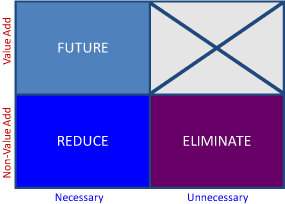Finding the Customer
Customer focus is a critical element in lean thinking. Do you set the pace of production to the customer demand rate (the Takt time)? Is the Voice of the Customer (VOC) used in product and service design? The answer is always an emphatic “Yes”. The customer is always critical to improvement activities.
But, as lean product/service companies start to address the vast lean waste reduction potential in back office areas such as IT, HR and Accounting, they are finding that for many employees, the concept of the “customer” can be confusing, difficult, and just maybe hasn’t been considered before. Who is their customer? Even asking the question can bring confusion, strange looks, and, often, silence.
The first answer for many is the boss or management. When asked to reconsider, the next response is usually a department, then another department, then the employees, then the executive team, then the stockholders, and before you know it, everyone is “the customer”. Unfortunately, none of these guesses are helpful with improvement activities. And, there is not an accurate, concise definition that fits every company.
The first step in solving this mystery is to distinguish between the external customer (the entity that buys the product or service of the organization) and the internal customer (the person or part of the organization that will receive the benefit of the process being performed). It should always be noted that the internal customer need never trumps the external customer need.
Next, think about what work or activities directly affects the external customer. In the IT function, this includes processes like designing a web interface for company information, or defining product specifications, or how best to accomplish online order entry. It would certainly include a project to implement customer self-service technology to enter orders, report quality problems, or register warranty information. An example of an HR process directly affecting the external customer would be the bonding of employees to enter customer locations. In Accounting, it will include collection activities at a minimum and maybe contract administration and certain investor relations activities. These types of activities are high priority opportunities for waste elimination through quality improvement, VOC input, and pace setting information.
However, to really engage and improve the functions that support the company in meeting the external customers’ overall needs, it is essential to identify who is the internal customer for every action that is done in these support processes. One way to visualize this is to think of the flow of water. It starts upstream and flows down…always moving toward a destination. So, in the HR, IT and Accounting “streams”, what is upstream (the “suppliers”) of the work being done? What is downstream (the internal customers)? The downstream is usually the best indicator of the internal customer…but not always. Be sure to dig deep downstream for a true identification.
A second way to identify the customer of a process is to ask, “Why do we do this process?” Ask the “why” question several times with no preconceived notion of the answer. Once you have a very simple answer of why the work is done, an activity statement can be written and used as a proxy for the customer in that process.For instance, using the IT example, we might divide the work into a few main streams:
- Creating technology applications
- Providing hardware and software access for the user
- Exploring new technology capabilities
By asking “why” on each stream many times, you will find the simple reason to perform each of these activity streams. For instance:
- We create technology applications that will allow manufacturing, sales, and accounting to improve quality and reduce time to perform their customer supporting activities.
- We provide hardware and software access for the user so they can have ability to perform their jobs 24/7.
- We explore new technology capabilities to help optimize the company output supporting the mission and strategy.
Once simple activity statements are in place, the IT teams can ask on every task, “Does this task directly improve our ability to meet the core purpose of this activity or value stream?” If it does, then it will add value to the process. However, it does not stop there. Once the task has been evaluated, the team can begin to figure out how to either eliminate unnecessary and non-value add tasks, or if the task is necessary but not value add, how to reduce the work required.
 Figure 1
Figure 1
This elimination process is illustrated in the chart below simplifying a few tasks from the very complex technology applications example.
| Task | VA/NVA | |
| Write the Application | VA | Improve later |
| Prioritize Request | NVA | Reduce prioritization need by reducing wait time (increasing application writing time), separate simple and complicated changes |
| Approve Request | NVA | Clarify criteria for acceptable changes, reduce approval steps |
| Test Application | NVA | Necessary; reduce test steps; increase quality checks within application writing process; identify most common problems and create protocols to avoid |
| Wait | NVA | Reduce handoffs, increase visibility of time sequence for all members of process including internal customer |
| Rework | NVA | Identify key root cause and reason; increase understanding of need for application; create repeatable workflows |
| And on, and on,… | … | … |
Understand the Process
Another challenge to improve a process in support areas is to identify the complete process across the enterprise and, then, to broaden each employee’s understanding of the process beyond their function. No process was intentionally built to be complicated and complex. But customer needs evolve, companies are merged, downsized or expanded, and there are new bosses and new problems. Then, without a customer focused, cross functional look at the activity streams, workarounds get created and non-value add activities proliferate.
A recent Kaizen improvement event was looking at their IT project approval and prioritization process. At the end of the event, an executive concisely summed up what many who fully participate in these events are realizing. He said, “I had no idea that when we asked for this information (holding his hands close together), it took this amount of work (holding his hands far apart). “ With his new outlook, he will seek out the wasteful unnecessary activities in order to free up more and more time to do the value add tasks.
IT, HR, and accounting processes span the entire organization. Take action today to apply lean improvements to eliminate non-value add and unnecessary work and to reduce the effort in necessary non-value add activities. The reward is immediate and a high multiple to the effort.

















